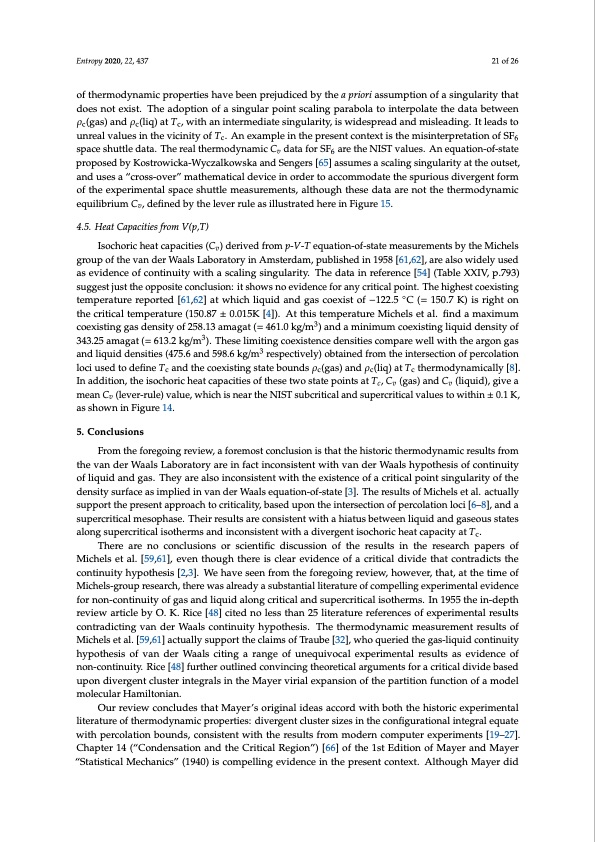
PDF Publication Title:
Text from PDF Page: 021
Entropy 2020, 22, 437 21 of 26 of thermodynamic properties have been prejudiced by the a priori assumption of a singularity that does not exist. The adoption of a singular point scaling parabola to interpolate the data between ρc(gas) and ρc(liq) at Tc, with an intermediate singularity, is widespread and misleading. It leads to unreal values in the vicinity of Tc. An example in the present context is the misinterpretation of SF6 space shuttle data. The real thermodynamic Cv data for SF6 are the NIST values. An equation-of-state proposed by Kostrowicka-Wyczalkowska and Sengers [65] assumes a scaling singularity at the outset, and uses a “cross-over” mathematical device in order to accommodate the spurious divergent form of the experimental space shuttle measurements, although these data are not the thermodynamic equilibrium Cv, defined by the lever rule as illustrated here in Figure 15. 4.5. Heat Capacities from V(p,T) Isochoric heat capacities (Cv) derived from p-V-T equation-of-state measurements by the Michels group of the van der Waals Laboratory in Amsterdam, published in 1958 [61,62], are also widely used as evidence of continuity with a scaling singularity. The data in reference [54] (Table XXIV, p.793) suggest just the opposite conclusion: it shows no evidence for any critical point. The highest coexisting temperature reported [61,62] at which liquid and gas coexist of −122.5 ◦C (= 150.7 K) is right on the critical temperature (150.87 ± 0.015K [4]). At this temperature Michels et al. find a maximum coexisting gas density of 258.13 amagat (= 461.0 kg/m3) and a minimum coexisting liquid density of 343.25 amagat (= 613.2 kg/m3). These limiting coexistence densities compare well with the argon gas and liquid densities (475.6 and 598.6 kg/m3 respectively) obtained from the intersection of percolation loci used to define Tc and the coexisting state bounds ρc(gas) and ρc(liq) at Tc thermodynamically [8]. In addition, the isochoric heat capacities of these two state points at Tc, Cv (gas) and Cv (liquid), give a mean Cv (lever-rule) value, which is near the NIST subcritical and supercritical values to within ± 0.1 K, as shown in Figure 14. 5. Conclusions From the foregoing review, a foremost conclusion is that the historic thermodynamic results from the van der Waals Laboratory are in fact inconsistent with van der Waals hypothesis of continuity of liquid and gas. They are also inconsistent with the existence of a critical point singularity of the density surface as implied in van der Waals equation-of-state [3]. The results of Michels et al. actually support the present approach to criticality, based upon the intersection of percolation loci [6–8], and a supercritical mesophase. Their results are consistent with a hiatus between liquid and gaseous states along supercritical isotherms and inconsistent with a divergent isochoric heat capacity at Tc. There are no conclusions or scientific discussion of the results in the research papers of Michels et al. [59,61], even though there is clear evidence of a critical divide that contradicts the continuity hypothesis [2,3]. We have seen from the foregoing review, however, that, at the time of Michels-group research, there was already a substantial literature of compelling experimental evidence for non-continuity of gas and liquid along critical and supercritical isotherms. In 1955 the in-depth review article by O. K. Rice [48] cited no less than 25 literature references of experimental results contradicting van der Waals continuity hypothesis. The thermodynamic measurement results of Michels et al. [59,61] actually support the claims of Traube [32], who queried the gas-liquid continuity hypothesis of van der Waals citing a range of unequivocal experimental results as evidence of non-continuity. Rice [48] further outlined convincing theoretical arguments for a critical divide based upon divergent cluster integrals in the Mayer virial expansion of the partition function of a model molecular Hamiltonian. Our review concludes that Mayer’s original ideas accord with both the historic experimental literature of thermodynamic properties: divergent cluster sizes in the configurational integral equate with percolation bounds, consistent with the results from modern computer experiments [19–27]. Chapter 14 (“Condensation and the Critical Region”) [66] of the 1st Edition of Mayer and Mayer “Statistical Mechanics” (1940) is compelling evidence in the present context. Although Mayer didPDF Image | Supercritical Fluid Gaseous and Liquid States

PDF Search Title:
Supercritical Fluid Gaseous and Liquid StatesOriginal File Name Searched:
entropy-22-00437.pdfDIY PDF Search: Google It | Yahoo | Bing
Sulfur Deposition on Carbon Nanofibers using Supercritical CO2 Sulfur Deposition on Carbon Nanofibers using Supercritical CO2. Gamma sulfur also known as mother of pearl sulfur and nacreous sulfur... More Info
CO2 Organic Rankine Cycle Experimenter Platform The supercritical CO2 phase change system is both a heat pump and organic rankine cycle which can be used for those purposes and as a supercritical extractor for advanced subcritical and supercritical extraction technology. Uses include producing nanoparticles, precious metal CO2 extraction, lithium battery recycling, and other applications... More Info
| CONTACT TEL: 608-238-6001 Email: greg@infinityturbine.com | RSS | AMP |